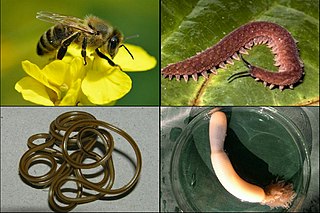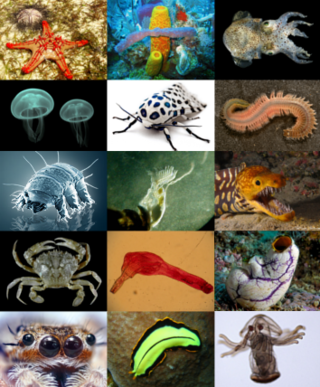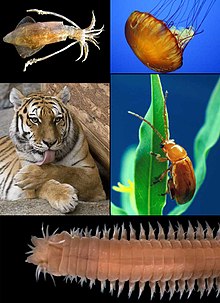
Cnidaria, is a phylum under kingdom Animalia containing over 11,000 species of aquatic animals found both in freshwater and marine environments, including jellyfish, hydroids, sea anemones, corals and some of the smallest marine parasites. Their distinguishing features are a decentralized nervous system distributed throughout a gelatinous body and the presence of cnidocytes or cnidoblasts, specialized cells with ejectable flagella used mainly for envenomation and capturing prey. Their bodies consist of mesoglea, a non-living, jelly-like substance, sandwiched between two layers of epithelium that are mostly one cell thick. Cnidarians are also some of the only animals that can reproduce both sexually and asexually.

Placozoa is a phylum of marine and free-living (non-parasitic) animals. They are simple blob-like animals without any body part or organ, and are merely aggregates of cells. Moving in water by ciliary motion, eating food by engulfment, reproducing by fission or budding, placozoans are described as "the simplest animals on Earth." Structural and molecular analyses have supported them as among the most basal animals, thus, constituting the most primitive metazoan phylum.

Bilateria is a large clade or infrakingdom of animals called bilaterians, characterized by bilateral symmetry during embryonic development. This means their body plans are laid around a longitudinal axis with a front and a rear end, as well as a left–right–symmetrical belly (ventral) and back (dorsal) surface. Nearly all bilaterians maintain a bilaterally symmetrical body as adults; the most notable exception is the echinoderms, which achieve secondary pentaradial symmetry as adults, but are bilaterally symmetrical as an embryo. Cephalization is also a characteristic feature among most bilaterians, where the special sense organs and central nerve ganglia become concentrated at the front/rostral end.

Ctenophora comprise a phylum of marine invertebrates, commonly known as comb jellies, that inhabit sea waters worldwide. They are notable for the groups of cilia they use for swimming, and they are the largest animals to swim with the help of cilia.

Ecdysozoa is a group of protostome animals, including Arthropoda, Nematoda, and several smaller phyla. The grouping of these animal phyla into a single clade was first proposed by Eernisse et al. (1992) based on a phylogenetic analysis of 141 morphological characters of ultrastructural and embryological phenotypes. This clade, that is, a group consisting of a common ancestor and all its descendants, was formally named by Aguinaldo et al. in 1997, based mainly on phylogenetic trees constructed using 18S ribosomal RNA genes.

Panarthropoda is a proposed animal clade containing the extant phyla Arthropoda, Tardigrada and Onychophora. Panarthropods also include extinct marine legged worms known as lobopodians ("Lobopodia"), a paraphyletic group where the last common ancestor and basal members (stem-group) of each extant panarthropod phylum are thought to have risen. However the term "Lobopodia" is sometimes expanded to include tardigrades and onychophorans as well.

Parazoa are a taxon with sub-kingdom category that is located at the base of the phylogenetic tree of the animal kingdom in opposition to the sub-kingdom Eumetazoa; they group together the most primitive forms, characterized by not having proper tissues or that, in any case, these tissues are only partially differentiated. They generally group a single phylum, Porifera, which lack muscles, nerves and internal organs, which in many cases resembles a cell colony rather than a multicellular organism itself. All other animals are eumetazoans, which do have differentiated tissues.

Eumetazoa, also known as diploblasts, Epitheliozoa or Histozoa, are a proposed basal animal clade as a sister group of Porifera (sponges). The basal eumetazoan clades are the Ctenophora and the ParaHoxozoa. Placozoa is now also seen as a eumetazoan in the ParaHoxozoa. The competing hypothesis is the Myriazoa clade.

A nerve net consists of interconnected neurons lacking a brain or any form of cephalization. While organisms with bilateral body symmetry are normally associated with a condensation of neurons or, in more advanced forms, a central nervous system, organisms with radial symmetry are associated with nerve nets, and are found in members of the Ctenophora, Cnidaria, and Echinodermata phyla, all of which are found in marine environments. In the Xenacoelomorpha, a phylum of bilaterally symmetrical animals, members of the subphylum Xenoturbellida also possess a nerve net. Nerve nets can provide animals with the ability to sense objects through the use of the sensory neurons within the nerve net.

Radiata or Radiates is a historical taxonomic rank that was used to classify animals with radially symmetric body plans. The term Radiata is no longer accepted, as it united several different groupings of animals that do not form a monophyletic group under current views of animal phylogeny. The similarities once offered in justification of the taxon, such as radial symmetry, are now taken to be the result of either incorrect evaluations by early researchers or convergent evolution, rather than an indication of a common ancestor. Because of this, the term is used mostly in a historical context.

Coelenterata is a term encompassing the animal phyla Cnidaria and Ctenophora. The name comes from Ancient Greek κοῖλος (koîlos) 'hollow', and ἔντερον (énteron) 'intestine', referring to the hollow body cavity common to these two phyla. They have very simple tissue organization, with only two layers of cells, and radial symmetry. Some examples are corals, which are typically colonial, and hydrae, jellyfish, and sea anemones, which are solitary. Coelenterata lack a specialized circulatory system relying instead on diffusion across the tissue layers.

Xenoturbella is a genus of very simple bilaterians up to a few centimeters long. It contains a small number of marine benthic worm-like species.

Animals are multicellular, eukaryotic organisms in the biological kingdom Animalia. With few exceptions, animals consume organic material, breathe oxygen, have myocytes and are able to move, can reproduce sexually, and grow from a hollow sphere of cells, the blastula, during embryonic development. Animals form a single clade.
The urbilaterian is the hypothetical last common ancestor of the bilaterian clade, i.e., all animals having a bilateral symmetry.

Protostomia is the clade of animals once thought to be characterized by the formation of the organism's mouth before its anus during embryonic development. This nature has since been discovered to be extremely variable among Protostomia's members, although the reverse is typically true of its sister clade, Deuterostomia. Well known examples of protostomes are arthropods, molluscs, annelids, flatworms and nematodes. They are also called schizocoelomates since schizocoely typically occurs in them.

The Spiralia are a morphologically diverse clade of protostome animals, including within their number the molluscs, annelids, platyhelminths and other taxa. The term Spiralia is applied to those phyla that exhibit canonical spiral cleavage, a pattern of early development found in most members of the Lophotrochozoa.

Nematoida is a clade of pseudocoelomate free living or parasitic animals. It consists of phyla Nematoda and Nematomorpha. Their closest relatives are the panarthropods, such as the tardigrades and velvet worms.

Siphusauctum is an extinct genus of filter-feeding animals that lived during the Middle Cambrian about 510 million years ago.

ParaHoxozoa is a clade of animals that consists of Bilateria, Placozoa, and Cnidaria. The relationship of this clade relative to the two other animal lineages Ctenophora and Porifera is debated. Some phylogenomic studies have presented evidence supporting Ctenophora as the sister to Parahoxozoa and Porifera as the sister group to the rest of animals. Other studies have presented evidence supporting Porifera as the sister to Parahoxozoa and Ctenophora as the sister group to the rest of animals, finding that nervous systems either evolved independently in ctenophores and parahoxozoans, or were secondarily lost in poriferans. If ctenophores are taken to have diverged first, Eumetazoa is sometimes used as a synonym for ParaHoxozoa.

Choanozoa is a clade of opisthokont eukaryotes consisting of the choanoflagellates (Choanoflagellatea) and the animals. The sister-group relationship between the choanoflagellates and animals has important implications for the origin of the animals. The clade was identified in 2015 by Graham Budd and Sören Jensen, who used the name Apoikozoa. The 2018 revision of the classification first proposed by the International Society of Protistologists in 2012 recommends the use of the name Choanozoa.





















